Recently described in 2009, Kaprosuchus is one of the latest additions to the extensive and continuously growing roster of known toothy prehistoric devilry. And that means nothing but good things for us paleo toy fans! With a name which aptly translates to “boar crocodile” (for obvious reasons), the 20 foot Kaprosuchus was an interesting terrestrial crocodyliform from Cretaceous Africa. The animal is known from a single complete skull which exhibits a variety of features that suggest a primarily land-based lifestyle, such as binocular vision and sharp, straight teeth which differ from the slightly hooked teeth of fish-eating, water-based crocodyliforms.
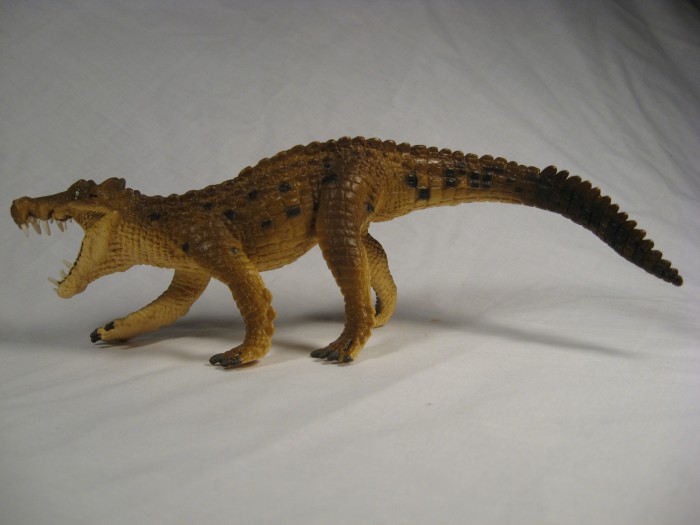
Safari have really been exercising their muscle and capability to produce fantastic prehistoric replicas in recent years, and their Kaprosuchus, which is new for 2011, is exceptional. I applaud them on all of the more obscure, but no less cool, genera which they have been reviving in plastic form. It takes some balls to go out on a limb with animals no one in the target market has heard of, but Safari’s sure got ’em! The first pictures I saw of this figure made me skeptical of the quality of the paint application, but after receiving one as a gift I am happy to say that no picture could ever do justice to how good this figure really looks, and I would have gladly bought it myself.
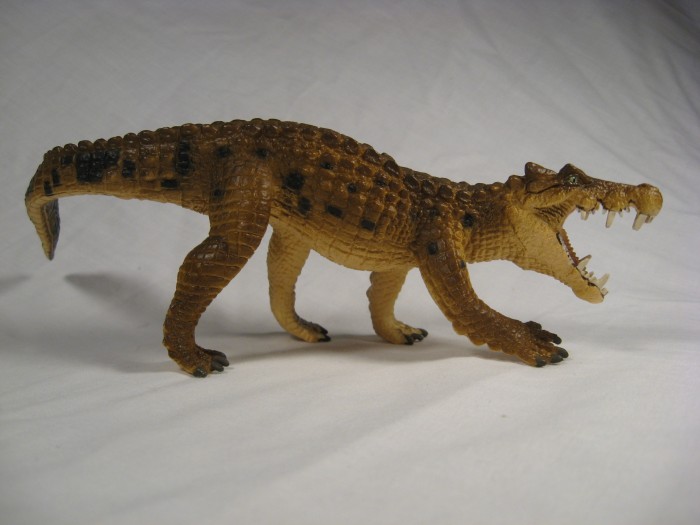
This figure is pretty sizable, at almost 8 in. (20 cm) in length, though it would be about 9 in. if the tail were straight. It’s about 2.5 in. (6.5 cm.) tall at the hips. As such, it’s far too large to be in 1:40 scale and fits much better in 1:30, meaning it’ll look good next to the two new Carnegie figures coming out this year! (Time periods and geographical locations aside.) The texture and detailing are top notch on this guy, with the whole body being covered in osteoderms and scutes reminiscent of modern crocodiles. Since only the skull is known for Kaprosuchus, some artistic license has been taken with the post-cranial anatomy (that is, everything but the head).
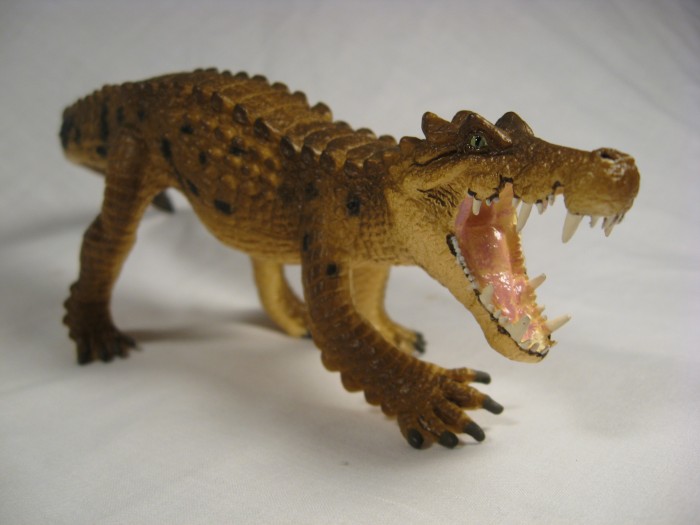
The colors are very natural and I’d say they probably aren’t too far from what it really looked like, but that’s just my opinion. The figure is molded in light tan plastic, which serves as the color of the underside. Along the back, flanks, limbs and skull it is painted a darker tan-brown color, becoming a much darker brown toward the tip of the tail. Select individual scutes along the sides and tail are painted black, sort of mimicking a modern saltwater crocodile, but some are painted more sloppily than others. Luckily it doesn’t detract a whole lot from the figure. Its claws are dark gray, the eyes are green with black slit pupils, and its teeth are white. The inside of the mouth and tongue is that kind of washed-out pinkish tan you see inside the maws of modern crocodilians and looks good.
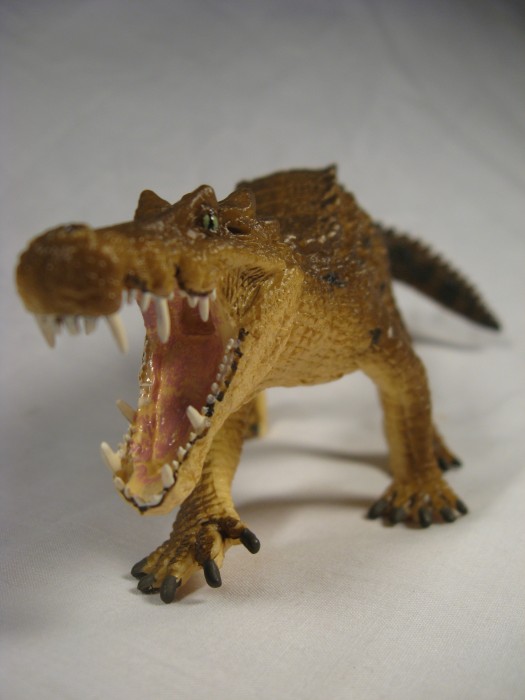
In terms of accuracy to the fossil material, Safari has done as good a job as possible. Aside from the large crests over the eyes which may or may not have been present, the skull is flawless. Even the pair of horns jutting from the back of the skull can be seen here. The skull is broad, short, and powerfully built, reflecting the diet of an animal which likely attacked dinosaurs on a regular basis. The deadly dentition looks perfect here, with the teeth individually sculpted and of correct lengths. There are notches in the upper jaw to allow the large lower caniniform teeth to slip past when the jaws are closed. The eyes are angled to give slight binocular vision.
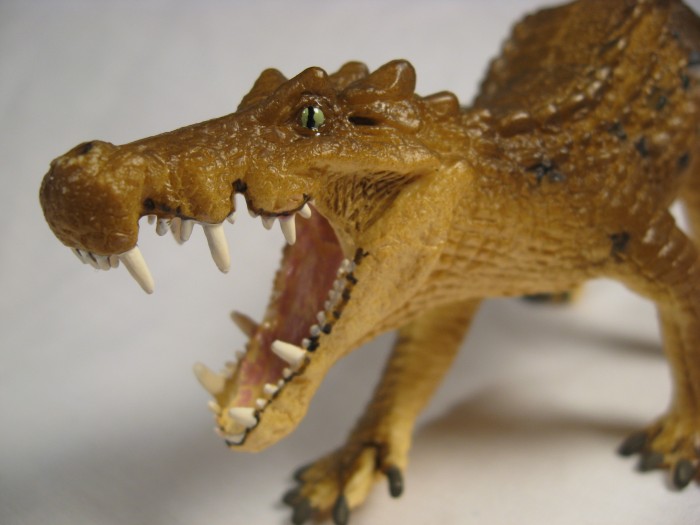
Like I said before, the rest of this animal’s anatomy is unknown, but I think Safari made a plausible effort here. The terrestrial lifestyle suggested by its skull indicates an active predator, one which would have needed the locomotory capabilities to run down other animals adapted to living on land. The positioning of the limbs here, being held more erect like a dinosaur or Rauisuchian, are far more likely to be correct than the splayed positioning of an aquatic crocodyliform’s limbs. The tail is reminiscent of an aquatic crocodile, but who’s to say this guy wasn’t a fair swimmer and didn’t enter water periodically? No one knows for sure, but the specialization in the skull already sets Kaprosuchus apart from most other crocodyliforms so I think it’s plausible for it to have had significant adaptations in its limb anatomy as well. And the massive amount of details, right down to the cloacal opening, brings the whole thing together quite nicely.
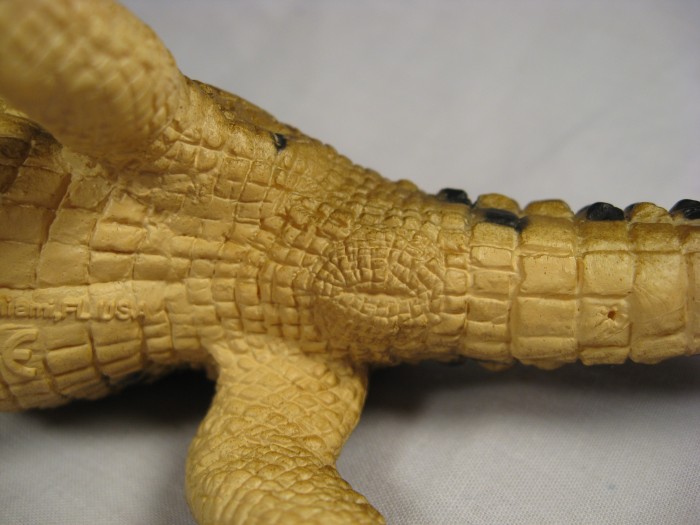
I can’t ever resist the chance to add new animals to my collection, and even if you consider yourself an exclusively dinosaur collector, I’d still urge you to splurge on this one, especially since Kaprosuchus coexisted with dinosaurs which means you can believably have it attacking them (at least your Late Cretaceous African dinos) in dioramas 😉 It’s really too beautiful to pass up, and pieces like this one show why I think Safari is solidly leading the paleo toy market right now. It’s not too pricey either at around $10 on average and can be found from a wide variety of retailers online since it was just released in January. Now available here.
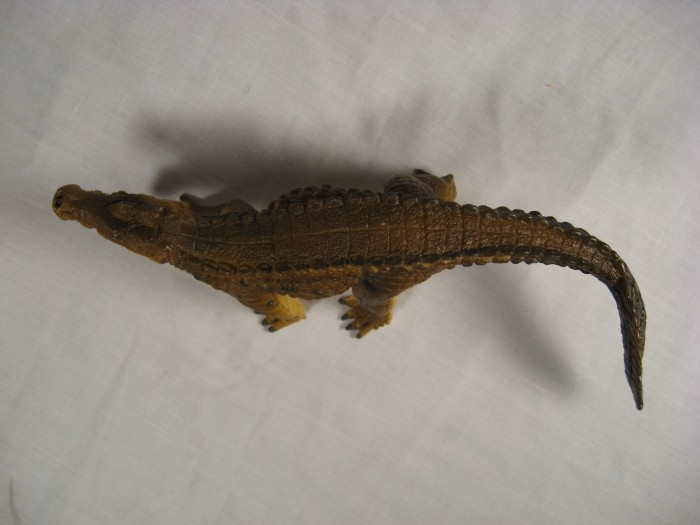

Disclaimer: links to Ebay and Amazon on the DinoToyBlog are affiliate links, so we make a small commission if you use them. Thanks for supporting us!




Wow, a toy crocodile with an anus. Never thought I’d see a figure that accurate.
[…] how does this walking fang factory compare to the one from Wild Safari? Well, as far as sheer sculpting detail and scariness are concerned, victory definitely goes to the […]
Alomejor no soy objetivo,porque las figuras de Safari/Carnegie son mis preferidas,pero hay que reconocer que son de lo mejorcito del mercado.Esta en concreto me parece fantástica: la textura de la piel está conseguidísima,así como la postura y la boca está muy bien hecha.Viéndola de lejos parece una cría de caimán o de cocodrilo actual.Se nota que los de Safari están echando el resto,cada vez lo hacen mejor y ponen el listón muy alto.Enhorabuena y espero que sigan en esta línea!.
Where would you find an accurate Deltadromeus figure?
Carnegie made one:)
That earlier comment by me from 2011 was actually a reply to a comment made by “Mr Clearup”. Mr Clearup had posted a number of comments on different reviews, including some that criticised figures for having pronated hands. On this review, they had commented, from what I remember, that this Safari Kaprosuchus would be used with two accurate Deltadromeus figures. Since the only Deltadromeus figure I knew of was the Carnegie figure which has pronated hands, and they had specified “accurate” Deltadromeus, I asked that question.
I thought Mr Clearup’s comments were… interesting, and I found some funny. They all got deleted though, I guess because some of them caused irritation. I’m reminded of Mr Clearup’s comments when seeing replies to them, like my earlier reply, and Horridus’s replies under the red and orange JP Velociraptor review and the Papo Styracosaurus review. What I can remember of Mr Clearup’s comments and exchanges that followed (like with Horridus) still makes me laugh now. 🙂
No sé lo que opinarán otros de los que escriben en el foro, pero me parece una figura de lujo. Como lo es toda la línea Safari en general, y para abreviar va mejorando año tras año.
Really cool model. Love it!